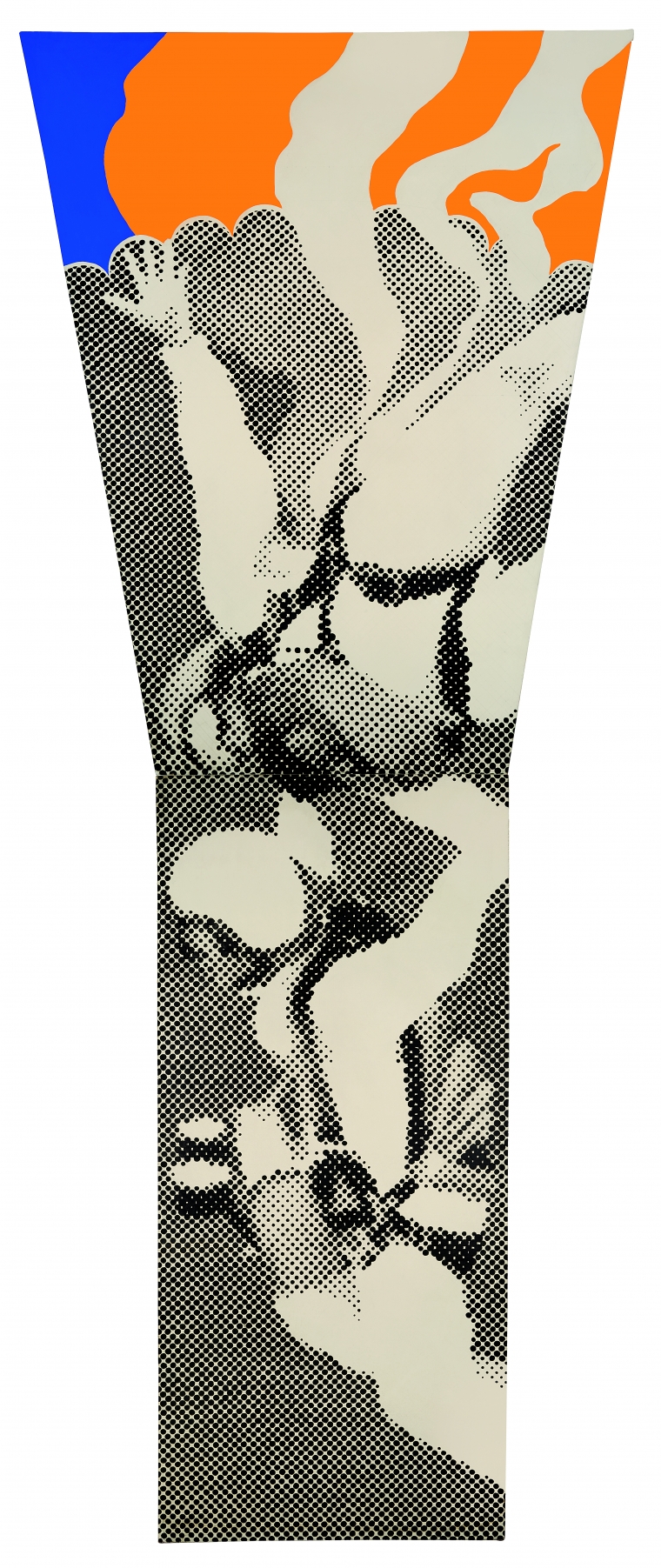Wedding Jump 1964

Wedding Jump
Catalogue raisonné no. 56
Artist's CR 054
1964
New York
Oil on irregular, shaped canvas
160 x 67 inches / 0 cm
-
Feigen-Palmer Gallery, Los Angeles, 1964–5chevron_right
-
Gerald Laing: Paintings, Drawings, Constructions, Prints, Richard Feigen Gallery, Chicago, IL, 1965chevron_right
-
N.M., 'Gerald Laing: Feigen-Palmer Gallery', Arts Forum, Marchchevron_right
-
Modern British and Irish Art Evening Sale, 19 November 2014, sale catalogue, Christie's King Street, London, 2014chevron_right
Selected Citations and Comments
Having produced his first Pop paintings in 1962, when he was still a student at St Martin’s School of Art in London, by the following year Gerald Laing had established not only his photographically-derived style but also carved out the categories of images that most interested him and that gave his work its distinct and instantly recognizable identity. In advance of Jean-Luc Godard’s Masculin Féminin, released in I960, a nouvelle vague film that explored the relationship between the sexes against the backdrop of popular youth culture, Laing had focused his attention on femininity and masculinity exaggerated into sharp contrasts. Reflecting the values of the time, before the arrival of a more vociferous feminism, women were celebrated for their attractiveness and erotic allure and men for their courage, risk-taking and sense of adventure. The feminine principle was represented by female film stars of the day, particularly from the European cinema, including Brigitte Bardot and Anna Karina, and by bikini-clad starlets and flawless beauties. The masculine principle was manifested in the heroics of sky-divers, pilots, astronauts and drag racers, adventurous men of action.
Wedding Jump occupies an unusual place in Laing’s work of the 1960s, showing as it does a man and woman in identical terms, each defined by the activity in which they are engaged. It was painted in 1964, the year in which he moved to New York, where in the previous year he had worked briefly as studio assistant to Robert Indiana. The picture commemorates a parachute jump from a light aircraft made by a couple as a spectacular and daredevil way of making their entrance to their own wedding reception. Based on a photograph that the artist had spotted in a newspaper or magazine, the image treats bride and groom as absolute equals in their decision (in more ways than one) to take the plunge and tie the knot: their white-clad bodies are not even easily distinguishable as male and female. As the owner of this painting remarks, recalling the correspondence he had about it ten years ago with the artist, ‘I guess it was for him something very emblematic of the American dream, a way to become a hero in real life, to perform such an exploit or extraordinary act that the magazines will communicate it; in brief, how to become a superstar.’
Wedding Jump appears also to be in an interesting dialogue with paintings by another British Pop artist, Allen Jones, not only in its use of the shaped canvas - a formal investigation on which Jones had embarked in his series of Bus paintings in 1962 - but also in its imagery of parachutists and entwined male and female couples floating in space. For Jones this formed part of a thematic exploration, derived in part from his reading of Jung and Nietzsche, of creativity as a union of female and male principles. In Jones’s two-part canvas Wunderbare Landung 1963, for instance, in which the parachute forms a large octagon surmounting a rectangle on which the clothed male and female figures fuse together and drift vertiginously earthwards, a direct correlation is made between the sexual act and the creation of a work of art. While Jones was referencing early 20th-century art, including the paintings of Paul Klee (from which he derived his title) and Marc Chagall, Laing releases himself from art history with the same abandon so ostentatiously displayed by the wedding couple. Meticulously mimicking the process of half-tone printing with a grid of dots painted by hand, Laing privileges an of-the-minute photograph from the mass media through which an anonymous couple have become (in Andy Warhol’s oft-cited words) ‘world-famous for 15 minutes’. The painting, of course, is not specifically about this now anonymous couple and their very public declaration of marriage. It celebrates, on a universal level, the reckless adventure on which any two people embark when they decide to throw caution to the wind and make their lives together., Modern British and Irish Art Evening Sale, 19 November 2014, sale catalogue, Christie's King Street, London, lot 21, pp.86-7
